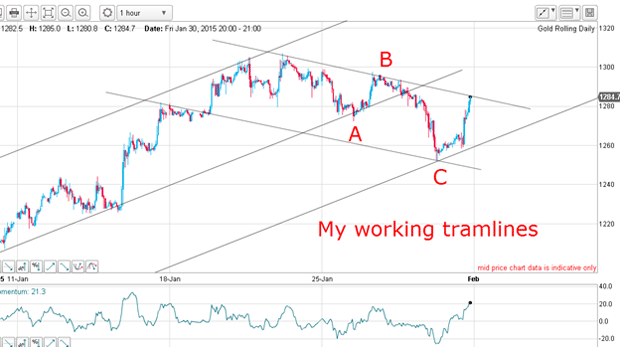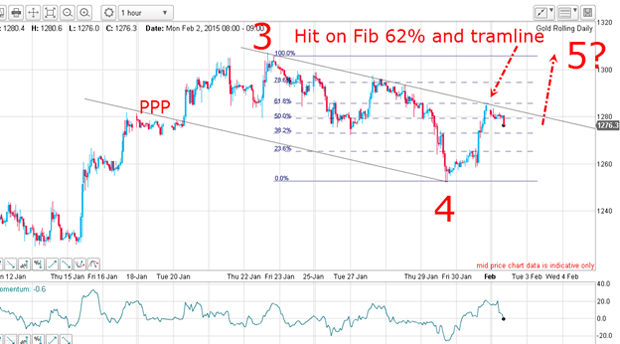On a roll: I called yet another twist in the gold market
Master the skill of acting against your first impulse and you can become a great trader yourself, says John C Burford.
I'm on a roll in the gold market. I've called the major turns since November.
Today, I want to reinforce the lessons laid out in Friday's post and show how my tramline methods can make you serious profits too.
On Friday, I left you with this hourly chart. It shows a third tramline (marked as T3) intersecting with the Fibonacci 38% level to show me exactly where to buy. That's marked in the chart with a pink box.
Subscribe to MoneyWeek
Subscribe to MoneyWeek today and get your first six magazine issues absolutely FREE

Sign up to Money Morning
Don't miss the latest investment and personal finances news, market analysis, plus money-saving tips with our free twice-daily newsletter
Don't miss the latest investment and personal finances news, market analysis, plus money-saving tips with our free twice-daily newsletter

Recall that prior to the $1,300 high last week, I was betting gold would go up. But chart signals showed me that the rally was likely to end soon, so I decided to take profits of $140.
That wasn't an easy decision, as I explained on Friday. When the market is going gangbusters in your direction, it's hard to sell. For all you know at the time, you might be giving up the trade of the century.
The goldbugs are back
How predictable! You see, forecasters have a tendency to get more and more bullish as the markets rise. That is human nature.
And where were these forecasters when gold was crashing through $1,150 last November, to multi-year lows? Naturally, they weren't to be seen.
Back in November, gold was trending downwards with no bottom in sight (that is, except to those of us who read the Elliott waves correctly).
But that is what a great swing trader does masters the charts, and masters their emotions. If you can master that skill of acting against your first impulse, you can become a great one yourself. That is the purpose of MoneyWeek Trader.
I want every one of you to become a great trader and you will become one when you start to master your emotions and not vice versa.
Tramlines told me where to trade
As I was writing on Friday, the Elliott wave A-B-C pattern confirmed to me that the market was likely to rally from the $1,250 level.
Here is the chart showing Friday's explosive action:

I can now draw in a second pair of tramlines (on the graph, the second pair slopes downwards from left to right). The lower tramline of this pair only has only one touch point (point C), but it has an excellent prior pivot point, which gives it validity.
That rally to my upper tramline allowed short-term traders to snag another hefty profit of around $40, as the price of gold moved up from $1,250 to $1,290. This added to the $140 I already made earlier this month, when I bet that gold would rise from $1,152 to $1,242.
Here's what the picture looks like this morning:

My second tramline pair is proving its worth. The market bounced off the upper tramline in that pair, right at the point where it intersects with the 62% Fibonacci level (as marked).
Elliott wave theory shows the way
Elliott wave theory says that a trend changes direction after five 'waves'. I count four waves so far from the December low, when this trend first began. If the theory holds, then I can expect gold to rally from this point. Under this picture, a new high above $1,300 becomes likely (point 5).
But with these lessons in how to use Fibonacci in conjunction with tramlines and Elliott waves, the gold market is a gold mine.
Get the latest financial news, insights and expert analysis from our award-winning MoneyWeek team, to help you understand what really matters when it comes to your finances.
John is is a British-born lapsed PhD physicist, who previously worked for Nasa on the Mars exploration team. He is a former commodity trading advisor with the US Commodities Futures Trading Commission, and worked in a boutique futures house in California in the 1980s.
He was a partner in one of the first futures newsletter advisory services, based in Washington DC, specialising in pork bellies and currencies. John is primarily a chart-reading trader, having cut his trading teeth in the days before PCs.
As well as his work in the financial world, he has launched, run and sold several 'real' businesses producing 'real' products.
-
 Buying infrastructure funds - 'cheap is not always cheerful'
Buying infrastructure funds - 'cheap is not always cheerful'Opinion Well-balanced infrastructure funds offer better prospects than high-yielding renewables funds, says Max King
-
 The new products and growth sectors driving America’s long-term winners
The new products and growth sectors driving America’s long-term winnersOpinion Felix Wintle, manager of the VT Tyndall North American Fund, highlights three favourite US stocks where he'd put his money